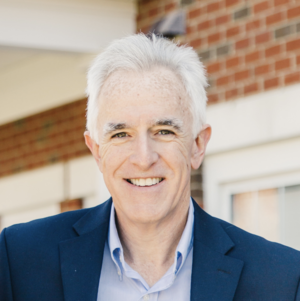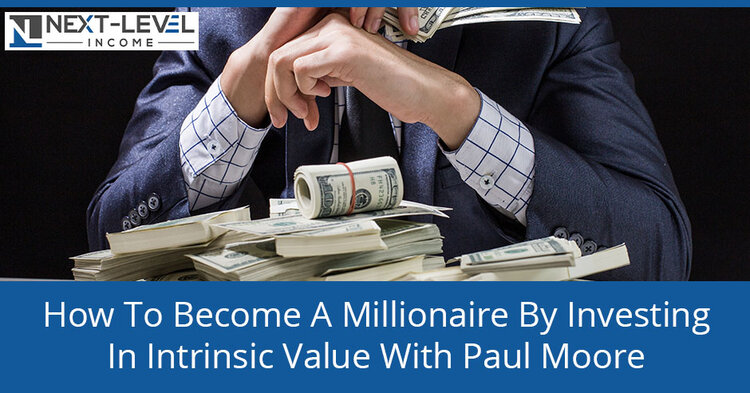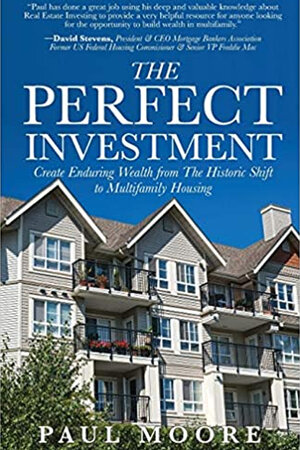Subscribe to The Next-Level Income Show
Have you ever thought about investing in intrinsic value? Paul Moore has definitely thought about it. When you evaluate investments, you need to examine how much an asset is worth and look for its intrinsic value. Catch Paul in this interview to learn why it’s important to invest in intrinsic value. Paul is the Founder and Managing Partner of Wellings Capital, a real estate private equity firm. He is also the author of The Perfect Investment as well as the forthcoming Storing Up Profits.
—
Watch The Episode Here:
Listen To The Podcast Here:
How To Become A Millionaire By Investing In Intrinsic Value With Paul Moore
On this episode, we have Paul Moore. Paul is the Founder and Managing Partner of Wellings Capital, a real estate private equity firm. Paul is the author of The Perfect Investment: Create Enduring Wealth from the Historic Shift to Multifamily Housing, as well as the forthcoming Storing Up Profits: Capitalize on America’s Obsession with STUFF by Investing in Self-Storage.
—
Paul Moore, welcome to the show.
It’s great to be here, Chris.
I’m excited to have you on the show. We’ve had some conversations. I read your book a few years back. We have a lot of friends in the industry that goes back. I can’t tell you how excited I am to be here. You’re right there, right near where my grandparents have spent the last five or so years of their lives in Lynchburg, Virginia.
It’s near Hokie Lane.
I’ve been through Lynchburg many times in my life.
We love being here. We also vacation in your town as well. We love Asheville.
Central Virginia is a little hidden gem for people that don’t know it. I won’t talk too much more about it so it stays that hidden gem. Paul, for people that don’t know about your background, maybe share a little bit more about how you ended up in Lynchburg and also what you did prior to getting into real estate.
I got an Engineering degree, which was my first mistake. I then got an MBA from Ohio State and went to Ford Motor Company. I didn’t know anything about being an entrepreneur. I loved Ford but I found myself continually trying to piddle around with stuff in the evenings and weekends. I realized I’m an entrepreneur at heart. My buddy and I, who felt the same way, quit. We start our own staffing firm in Detroit. I was eventually a finalist for Michigan Entrepreneur of The Year. That got some attention. We sold the company. I found myself with a couple of million dollars. I didn’t know what to do with it or my life. It was the late ’90s. I was wondering about Y2K and all kinds of stuff. We moved from the barren flatlands of Detroit to the Blue Ridge Mountains of Virginia. We bought 120 acres on top of a mountain.
We invited some friends to move in next door. We started this international student, nonprofit organization to give students a farm experience in the Blue Ridge Mountains and that was fun. I got into flipping houses then flipping waterfront lots at Smith Mountain Lake, building houses, did a small subdivision. Chris, I often wondered what it would be like to be in commercial real estate. I knew the wealthiest people in the world were in commercial real estate. At least they sustain their wealth that way. I didn’t know how to get into large multifamily and all that. When I finally stumbled into it from building some apartments in North Dakota during the Bakken oil boom, I loved it. That’s where we stayed in commercial real estate.
My grandparents had a farm there outside of Charlottesville. With an Engineering MBA, I’m like listening to myself. I’m a couple of years behind you. I became familiar with you, Paul because I read your books. Your first book was about multifamily real estate. I took a lot of inspiration from that. I read at least a dozen books before I wrote mine. They were in and around the multifamily space. How do you do this? How do you put your own spin on it? I loved your book. I know we have some similar mentors in the area. Maybe talk about your experience educating, writing the book. What made you decide to go that route?
I have a lesser-known book from 2008. That was preceded by a guy named Perry Marshall. He’s an online marketing guru. He wrote The Definitive Guide to Google AdWords and then the Ultimate Guide to Google AdWords back in the early 2000s. I saw how famous he got. He went from nothing to pretty famous as an online marketing guru. I noticed other people that wrote books did that. After going through 37th Parallel, an incredible mentoring coaching program, I took everything I learned from that plus my own experience managing our North Dakota plaza, apartments, quasi-hotel projects. I basically said, “I need to write an eBook.” The eBook was like the first book I had written years before. I wrote a book on Smith Mountain Lake real estate. I think I skipped that. I wrote that in 2008, The Definitive Guide to Smith Mountain Lake Real Estate. Chris, I’d made over $1 million in commissions easily from that book.

Intrinsic Value: Cap rates are roughly cut in half. There are a lot of mom-and-pop owners that have gained traction because of that without doing anything other than being mediocre.
People go, “If I’m going to get a realtor at Smith Mountain Lake, I want to get the guy.” It turned out to be the team because I don’t do real estate. It turns out to be I want to get the team who wrote the book. I had done real estate at Smith Mountain Lake right up to 2008. That’s when I wrote the book. I stepped back into owning the company. That was a boom. I thought, “I’ll do the same with multifamily.” I wrote an eBook. The eBook kept going and expanding. Honestly, that’s a testament to Chad Doty, Dan Chamberlain, the guys at 37th Parallel because they taught me so well. I had already owned and operated multifamily for a long time. I shared this with you before. I didn’t even know what a rent roll was at the end of owning that property. To us, it was a list of tenants.
It’s phenomenal that we share that same background. I have to often tell the story about starting as an investor with that. I always tell people when they ask for advice like, “What should I do?” I’m like, “You need to find a mentor. You need to find somebody that you can learn from. Otherwise, you’re paying and making those mistakes.” I’m intrigued though by the North Dakota property. Tell me a little bit more about how big was it. I know about the Bakken oil boom out there. Who did you work with out there? Did you fly out there and find a builder? How did that all work out?
To summarize, my buddy and I invested in oil and gas there in 2010. I’m going to take a quick sidetrack here. Investing in oil and gas is great but let’s face it, it’s speculation. True wealth can be built from speculation but more reliable wealth can be built from investing. Speculating is when your principal is not safe and you have a chance to make a return. Investing is when your principal is very safe, though not completely and you have a chance to make a return. Paul Samuelson, the first economist who got the Nobel Peace Prize, and Chad Doty quoted this. He said that, “True investing should be boring. Investing should be more like watching paint dry or watching grass grow. If you want excitement, take $800 and go to Las Vegas.” I took that to heart. When we lost a lot of money, throwing it to the bottom of a hole in the ground in North Dakota that did not produce the oil that was expected, it hurt. My buddy and I noticed that there were thousands of job openings. There were people living in their pickup trucks, in their cars even, in RVs in the cold North Dakota.
They’re making $150,000. They were killing it.
They’re making a massive amount of money. They couldn’t find a place to live. In the summer, some of them were camping. I kid you not. They would pull these old campers up there. Some of them started fires in the living room to stay warm. We’re talking 40 degrees below, the wind chill and all this stuff. I got a piece of property under contract. It was 75 acres for $2,500 an acre. There were no rights to it. We started building multifamily cabins on this. We put together these big fourplexes. We did seven fourplexes and then a whole bunch of duplex cabins. We decided we were going to build it high-end. We had granite, nice cabinets and nice everything so that when oil prices took a dive, we didn’t know if they ever would but we thought that they could, we wanted to be the last one standing.
We did that for a number of years. Oil prices were still about $100 a barrel. We had to sell it. We sold it for a great profit. Here’s the funny thing along the way that I hadn’t realized were there. Apartment rentals across the heartland, you might say that they run somewhere around $1 per square foot per month. A 900 square foot apartment might rent for around B class $900 a month for example. We were at $1 square foot. We were renting for $13 a square foot and staying almost full. That included utility, internet, water, sewer, cable and all that stuff. It was furnished and utilities paid but we were charging $4,000 a month for a 300 square foot furnished apartment.
My uncle lives in Colorado. He’s told me similar stories about groups that were out there during that time. It’s amazing, selling the picks and shovels.
That’s exactly what our motto was.
That was your first foray into multifamily, Paul.
I exited that. We built a Hyatt hotel. My business partner did. My business partners are smart guys but got caught with the oil price downturn and all that happened after that. It did not go well so I decided I wanted to stay in multifamily. That’s when I discovered 37th Parallel.
I love your expression that investing should be boring. I tell investors a lot of times, “This is like the Warren Buffett strategy of real estate.” I use Warren Buffett because he’s a boring guy. Value investing is boring but I’ll tell you what, for somebody that’s averaged 20% over his investing career, it’s pretty incredible. I’ll take boring when it comes to that.
I’m writing my fourth book. It’s called Warren Buffett’s Rules for Real Estate Investors. One of the points of the book is that his life is horrendously boring in the last 75 years of his life, for the most part. I can’t imagine tolerating a week of his life. It’s reported that Jeff Bezos asked him, “Why doesn’t everybody just copy your strategy? It’s not that hard, Warren.” Warren apparently chuckled and said, “People don’t want to get rich that slowly.”
The thing I love most aside from all that about Warren Buffett is he’s in his 90s and he’s still going. He eats McDonald’s. He drinks his Cokes. It cracks me up but I love it. If you’re 90 and you’ve done that well over that period of time, he’s got something figured out. You focused on multifamily for a large period of time. We could talk a lot about that but that’s not your primary focus.
I was a dedicated shiny object chaser. In fact, if you missed it, I didn’t go over about fifteen years of my biography but in addition to all this stuff I said I did, I started a wireless internet company with a business partner Bakken Wireless. It worked on other subdivisions. I did all kinds of stuff. Some of it went well. Some of it was terrible and lost money like the oil deal. I promised my wife. I said, “I am sticking with multifamily from here on out. If you look at the demographics of multifamily.” If you look down the road, the next several decades at the population, the immigration and all the statistics that would make us think multifamily is the place to be, I was committed, I’m going to stick with multifamily. After beating our head against the wall for a number of years looking for deals and after becoming suspicious when I saw some multifamily syndicators raising a whole bunch of extra money as part of their raise to pay investors their returns for the first couple of years, I’m thinking, “That’d be illegal. I sure don’t want to use that as a business strategy counting on rents to go up to break even. I don’t think that’s a good idea.”
We started wondering what is it out there that looks like multifamily years ago? What kind of assets has a lot of value add left on them? Though we didn’t know this term or we didn’t think of it years ago, I will say now, “Where is the intrinsic value?” Look at Buffett’s strategy as we’re working on this book. He looked for stuff that had an extrinsic value, which was the stated share price or the value of the company with an intrinsic value and that was a hidden value that was far higher than that. I’ve got a whole story about how he did that with Burlington Northern and Apple. When he did that, he was able to create incredible value for himself and shareholders. I didn’t think of it this way years ago but looking back on it, we were looking for intrinsic value that exceeded extrinsic value. We found that in a couple of asset classes that were similar to multifamily but different. One is the other multifamily. Do you remember the other white meat, which was pork from those advertisements? The other multifamily is mobile home parks.
The other type that we found that we like is self-storage. We have found that there are a lot of mom-and-pop owners that have already gained incredible traction from the fact that cap rates are cut roughly in half. Without doing anything other than being mediocre, they’ve effectively doubled the value of their properties. They have the desire, the resources or the knowledge to improve their properties and increase income. A great operator can pay them top dollar for what they have, turn around and potentially double or even quadruple the value of not the asset but the equity using safe leverage by acquiring from a mom-and-pop. Here’s the thing. We believe that we haven’t proven this number but we believe that about 93% of multifamily above 50 units is owned by companies that have often already run the value add out of their properties. About 85% of mobile home parks and 50% of self-storage are owned and operated by mom-and-pop operators. There’s a lot of intrinsic value there that hasn’t been tapped. We are partnering with operators who know how to tap that value.
My uncle is a small business owner. He lived in Colorado. Years ago, we started looking at different businesses to buy different opportunities out there. That’s where he always said, “Chris, you got to look at these mom-and-pops.” He preached and told me how to do that. I agree with that. It is amazing. I’ve been underwriting some mobile home parks around the Asheville area with some operating partners that I know here. It’s the same thing. It blows your mind when you walk around and you see the lack of effort. They don’t want to do it or maybe it’s the knowledge. That’s what we were looking at. The owner got into it. They said, “This is a great spot.” They don’t want to do it. They don’t want to be in it but they’ve made money because of that cap rate compression. They’re happy to sell it at a profit and do that. In anticipation, when is your book launch?
My latest book is called Storing Up Profits: Capitalize on America’s Obsession with STUFF by Investing in Self-Storage. BiggerPockets Publishing. It’s supposed to be out by the end of October 2021. With the Warren Buffett book, I’ve got two potential publishers, Morgan James and BiggerPockets. Once we decide on that, we will launch that book. Usually, it takes about eleven months once you get a publisher signed. I’m guessing late 2022 even though the book manuscript is almost done.

Intrinsic Value: Tenants in a mobile home park tend to stay awhile. You can’t raise rents willy-nilly and expect these people on generally lower incomes to be able to afford that.
It’s over it. It’s a big gold house. I’m joking. It would be neat. My buddy came in and saw it when it was under construction. He goes, “Chris, your house looks like a spaceship inside.” I’m a numbers guy, Paul. I learned about this from a contact here in Asheville. We were looking for air purification systems. This was fortunate. We installed these pre-COVID. It kills all viruses. It enhances the air quality. One of the products he had sitting there was called Copper Fleck. If you’re interested in checking it out, it looks like aluminum foil but it’s copper. It’s perforated. It breathes. What sold me is because it reflects heat. It also has a nice insulative feature. When he shared it with me, he told me about the cost. I looked at the energy savings. The product paid for itself. I thought, “What’s the harm in installing this in my house as additional insulation if it protects me and enhances our health?” The downside is if I sit on my back deck, I get no cell service. If I sit behind my house, it reflects the cell reception. It’s pretty cool.
I would love to know how to get rid of 5G as far as the radiation from it. I can’t wait to hear how much it costs. We’re thinking about building a house as well.
One last question, Paul, before you share a little bit more information about where our readers can keep up with you here. If you could go back to your 25-year-old self and give yourself a piece of advice, what would it be?
This might sound self-serving but I hope not. I’m going to try to keep it not from not being that way. My business partner, the guy that did the staffing company with, the multifamily and the Bakken, also did the Hyatt hotel. He ran for Governor of Colorado years ago. He got to rub shoulders with some very wealthy people including billionaires and stuff. He came back to me one day. He goes, “These guys have more or less the same education as us, the same IQ, the same business savvy. I think I know what the difference is.” I’m like, “I can’t wait to hear this.” He said, “They’re billionaires and we’re millionaires.”
They found a lane in their late teens and sometimes in their twenties and they stayed in that lane. They said no to 10,000 distractions along the way. We talked about Warren Buffett. He found that lane at eight years old. Bill Gates found that lane as a teenager. Lots and lots of people found their lane, stuck with it and said no to lots of distractions. If I had to tell my twentysomething-year-old self, it would be first of all, jumped straight into commercial real estate. That could be commercial multifamily, self-storage, mobile home park, cell towers, lots of stuff. Number two, stay in one lane and become an expert at it.
It’s got to be some of the top three pieces of advice I’ve had on the show. That’s fantastic. I fell for the same thing. I bought my first property at 21. Ray Alcorn wrote a book. He’s from Blacksburg, Virginia.
I got that book right here.
It’s a big, thick one.
He wrote a $600 book.
This is the guy that wrote the Bible. He said, “Go learn how to operate a building.” I was like, “That’s great. That sounds too slow to me. I’m going to go make money somewhere else.” If I can go back, I would do the same thing. That’s the advice I give to my younger coaching clients. Paul, this has been a blast. We’re going to have you back on the show here. What’s the best way for our readers to keep up with you and learn about your book that’s launching in the near future as well as your podcast?
I had a hard time figuring how to get into commercial real estate over the years. We wanted to make it easy for people. They can go to my website. They can get a free course on how to get involved in commercial real estate investing. That would be at WellingsCapital.com/resources. You can get a lot of resources there, all free. We can connect with you more there.
Thank you so much, Paul. It’s been a blast having you on the show. It’s always great talking to you. I hope you enjoy the rest of your time here.
Same here, Chris. Thank you. It’s been an honor.
—
I hope you found this episode valuable. I have one more thing to give to you. We have a page for my coaching clients where you can get a free copy of my book as well as much more from previous guests on the show. Check out NextLevelIncome.com/coaching to get a free copy of my book, audiobook and much more. I’ll send you a copy of my book and cover all the shipping costs as a thank you for reading the show. Also please like, share and take 90 seconds to give us a rating on Apple Podcasts.
Important Links:
-
The Perfect Investment: Create Enduring Wealth from the Historic Shift to Multifamily Housing
-
Storing Up Profits: Capitalize on America’s Obsession with STUFF by Investing in Self-Storage
-
How to Lose Money – podcast
-
Apple Podcasts – Next-Level Income Show
About Paul Moore

After a stint at Ford Motor Company, Paul co-founded a staffing firm where he was a finalist for Michigan Entrepreneur of the Year. After selling to a publicly traded firm, Paul began investing in real estate. He founded multiple investment and development companies, appeared on HGTV, and completed over 100 commercial and residential investments and exits.
He has contributed to Fox Business and The Real Estate Guys Radio and is a regular contributor to bigger pockets, producing regular live video and blog content regularly. Paul also co-hosted a wealth-building podcast called How to Lose Money and he’s been a featured guest on over 200 podcasts.
Paul is the author of The Perfect Investment – Create Enduring Wealth from the Historic Shift to Multifamily Housing as well as the forthcoming Storing Up Profits – Capitalize on America’s Obsession with Stuff by Investing in Self-Storage.
Paul is the Founder and Managing Partner of Wellings Capital, a real estate private equity firm.
Love the show? Subscribe, rate, review, and share!
Join the Next- Level Income Show Community today:
Tagged: Multifamily, Intrinsic Value, Extrinsic Value, Self-Storage, Mobile Home Parks, Commercial Real Estate, Group 3



Subscribe to The Next-Level Income Show